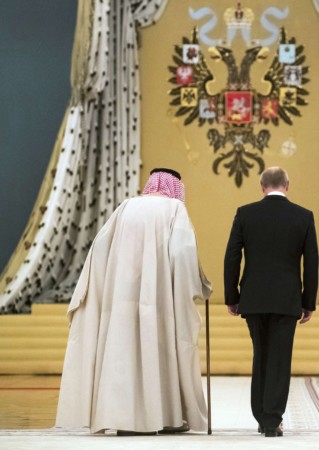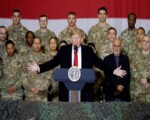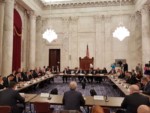European Union - Institute for Security Studies
RUSSIA’S RETURN TO THE MIDDLE EAST
BUILDING SANDCASTLES?
Executive Summary
Russia’s political, diplomatic, military and economic footprint in the Middle East and North Africa (MENA) has expanded visibly over the last decade. This Chaillot Paper provides a detailed account of Russia’s spectacular return to the region. The paper depicts how major regional players have adjusted to the new reality but also addresses the question of the costs incurred by Russia’s rise in Middle Eastern geopolitics, as well as the sustainability of its posture.
Although Russia has worked painstakingly to rebuild its influence and standing in the region since the mid-2000s, its efforts only began to pay off meaningfully in the wake of the Arab Spring. This is when Russia’s resurgence in the region became clearly evident, culminating with the first major combat deployment of the Russian armed forces in 2015 in a war theatre located far beyond the post-Soviet neighbourhood.
Russia’s dramatic re-emergence in the Middle East and North Africa is dictated first by economic and diplomatic imperatives. Examples include its efforts to engage the Persian Gulf monarchies in intensive energy diplomacy, its growing grain exports to MENA, and its own imports of fruit and vegetables from the region to offset the effects of the partial food embargo against the EU. Russia has also skilfully managed to overcome the diplomatic isolation in which the country found itself after the annexation of Crimea by playing the Middle Eastern card.
Russia’s comeback has also been greatly facilitated by a number of politico-military opportunities. The Arab Spring and the subsequent wars in the region temporarily weakened ruling regimes (Egypt) or led to the collapse of regional powers (Syria, Libya), while the rise of Daesh or the so-called Islamic State of Iraq and Syria (ISIS) put the threat of terrorism firmly back on the international security agenda. The increasingly chaotic situation in the Middle East, coupled with the waning commitment of the US, has nurtured local demand to explore alternative partnerships, and Russia has come to represent an appealing interlocutor for many regimes. Overall this constellation of circumstances provided Moscow with an opportunity to start filling some of the power vacuum left by the absence of US and European leadership, boost its regional diplomacy and reinsert itself militarily in the region under the banner of the fight against international terrorism.
Despite doomsday predictions that it would be dragged into a quagmire in the region, Russia managed to achieve several immediate successes. The military intervention in Syria ultimately rescued its key regional client. Russia’s proactive energy diplomacy in the region helped to eliminate a glut on the oil market, which had previously kept prices down. Russia’s arms manufacturers have successfully expanded their presence in existing markets and penetrated new ones, as attested by the fact that in 2017 the Middle East absorbed the largest share of Russian arms exports. Moscow has skilfully navigated between regional powers with opposite interests: Israel and Iran, Saudi Arabia and Qatar or Iran and Saudi Arabia. Its agile diplomacy backed by credible force has turned Russia, at least in the short run, into an indispensable power in the region.
However, regional successes have also had a downside. Military, diplomatic and economic victories have come with costs which in turn militate against Russia’s chances of entrenching itself as a powerbroker in the region in the long run. Russia has won several battles in Syria and through its military intervention saved the Assad regime from near collapse, but it has failed so far to secure a political settlement in the country. And ironically if Russia manages to secure such an outcome, Moscow’s attractiveness for the regime in Damascus will significantly decline. When it comes to rebuilding the country and seeking funds for reconstruction, the Syrian government, whether led by Assad or a new ruler, is likely to turn to wealthier players to foot the bill. Moreover, Russia has so far failed to reap any substantial economic benefits from its intervention in Syria.
‘Afghanistan syndrome’ still imposes severe limits on how many soldiers Russia is ready to deploy officially overseas. As there is still great public sensitivity to high military losses the Russian government has preferred to minimise troop casualties as much as possible by prioritising stand-off warfare (known in Russian military jargon as ‘contactless warfare’) and instead to send mercenaries to shoulder the major brunt of fighting on the ground. Furthermore, Russia’s limited expeditionary capabilities, exposed during the operation in Syria, constrain its ability to deploy large numbers of troops at long distance at any one time. The country’s anaemic economic growth does not generate enough resources to invest in building extensive expeditionary forces and capabilities. These constraints are reflected in Russia’s arms acquisition programme for the next decade which has significantly scaled back investments in naval capabilities and implicitly in power projection overseas.
Moscow’s skilful energy diplomacy in the Middle East has brought the price of oil to a level that suits Russia’s interests, enabling Russia to return again to a nondeficit budget. Overall, it has helped to stabilise finances and improve the country’s macroeconomic outlook. At the same time, Russia has fewer incentives now to conduct reforms which would help to alleviate its heavy reliance on exports of raw materials. Successful energy diplomacy keeps Russia solidly anchored – indeed trapped – in a resource-based economy model, and thus highly dependent on the external economic environment.
Russia’s comeback in the MENA region is palpable in the military and diplomatic fields. Moscow has also made headway in restoring its regional standing in the armaments and energy markets. But for all its renewed clout, Russia’s staying power in the Middle East remains to be proven, as it lacks sufficient financial and economic means to sustain its geopolitical ambitions. And even Moscow’s diplomatic influence should not be taken for granted. Regional leaders are happy to engage with Russia, respond favourably to its overtures and exploit its return to the region for their own benefit. But all are tough partners over which Russia has little leverage if they do not see eye to eye. Last but not least, the permissive regional context which allowed Russia’s comeback may not last long. The US and Europe in the last decade dismissed, and ultimately missed, Russia’s growing role in the Middle East. But they
are now alert to the challenge that this may pose, and thus Russia may be in for a more difficult ride in the Middle East in the coming years as it risks facing stiffer opposition both from within and outside the region.
The complete ISSUE Report can be downloaded here:
Institute for Security Studies - Russia's return to the middle east






Leave a Reply